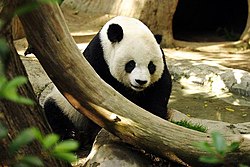Panda raksasa
| Giant Panda | |
|---|---|
| Klasifikasi ilmiah |
Status konservasi: Terancam
Templat:Taxobox image Templat:Taxobox begin placement Templat:Taxobox regnum entry Templat:Taxobox phylum entry Templat:Taxobox classis entry Templat:Taxobox ordo entry Templat:Taxobox familia entry Templat:Taxobox genus entry Templat:Taxobox species entry Templat:Taxobox end placement Templat:Taxobox section binomial simple Templat:Taxobox end The Giant Panda (Chinese: 熊貓; pinyin: xióng māo), Ailuropoda melanoleuca ("black-and-white cat-foot"), is a mammal now usually classified in the bear family, Ursidae, that is native to central China. The Giant Panda lives in mountainous regions, like Sichuan and Tibet. Toward the latter half of the 20th century, the panda became somewhat of a national emblem for China, and is now used in Chinese gold coins.
The Chinese name means "bear-cat," and can also be read in reverse to mean the same thing. Its Western epithet is named after the Red Panda. It used to be known as Mottled Bear (Ailuropus melanoleucus).
Despite being taxonomically a carnivore, their diet is overwhelmingly herbivorous. In fact, it lives almost entirely on bamboo. Technically, like many animals, they are omnivores, as pandas have been known to eat eggs, and they consume some insects along with their bamboo diet. These are necessary sources of protein. Their ears wiggle when they chew.
It is also distantly related to the Red Panda, but the shared name appears to derive from their common bamboo diet. Until its relation with the Red Panda was discovered in 1901, the Giant Panda was known as parti-coloured bear.
For many decades the precise taxonomic classification of the panda was under debate as both Giant Pandas and Red Pandas share characteristics of both bears and raccoons. However, genetic testing has revealed that Giant Pandas are true bears and part of the Ursidae family. Its closest bear relative is the Spectacled Bear of South America. Disagreement remains about whether or not Red Pandas belong in Ursidae or the raccoon family, Procyonidae.
Giant Pandas are an endangered species, threatened by continued loss of habitat and by a very low birthrate, both in the wild and in captivity. About 1,600 are believed to survive in the wild. The Giant Panda is the symbol of the World Wildlife Fund (WWF), a conservation organization (http://www.wwf.org).
The Giant Panda has an unusual paw, with a "thumb" and five fingers; the "thumb" is actually a modified wrist-bone. Stephen Jay Gould wrote an essay about this, then used the title The Panda's Thumb for a book of collected essays.

The Giant Panda was first made known to the West in 1869 by the French missionary Armand David (1826–1900). The Giant Panda has long been a favourite of the public, at least partly on account of the fact that the species has an appealing baby-like cuteness that makes it seem to resemble a living teddy bear. The fact that it is usually depicted reclining peacefully eating bamboo, as opposed to hunting, also adds to its image of innocence.
Loans of giant pandas to American and Japanese zoos formed an important part of the diplomacy of the People's Republic of China in the 1970s as it marked some of the first cultural exchanges between the PRC and the West.
By the year 1984, however, pandas were no longer used as agents of diplomacy. Instead, China began to offer pandas to other nations only on 10-year loans. The standard loan terms include a fee of up to US$1,000,000 per year and a provision that any cubs born during the loan are the property of the People's Republic of China.
In 1998 a lawsuit filed by the WWF spurred the U.S. Fish and Wildlife Service to require U.S. zoos seeking to import pandas to ensure that half of the fee charged by China be channeled into conservation efforts for wild pandas and their habitat before the service will issue a permit allowing the pandas to be imported.
Pandas in pop culture
Genma Saotome is a cartoon character from the manga Ranma 1/2 by Rumiko Takahashi. Though he is normally a human, he mostly appears as a panda (due to a magical curse) during the series.